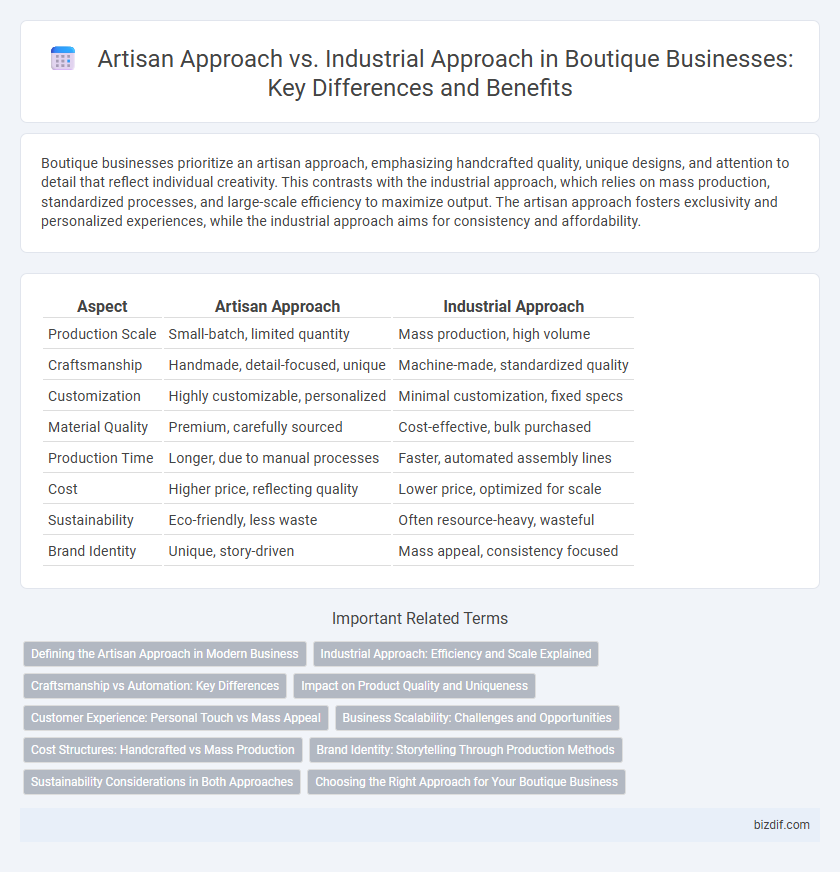Boutique businesses prioritize an artisan approach, emphasizing handcrafted quality, unique designs, and attention to detail that reflect individual creativity. This contrasts with the industrial approach, which relies on mass production, standardized processes, and large-scale efficiency to maximize output. The artisan approach fosters exclusivity and personalized experiences, while the industrial approach aims for consistency and affordability.
Table of Comparison
| Aspect | Artisan Approach | Industrial Approach |
|---|---|---|
| Production Scale | Small-batch, limited quantity | Mass production, high volume |
| Craftsmanship | Handmade, detail-focused, unique | Machine-made, standardized quality |
| Customization | Highly customizable, personalized | Minimal customization, fixed specs |
| Material Quality | Premium, carefully sourced | Cost-effective, bulk purchased |
| Production Time | Longer, due to manual processes | Faster, automated assembly lines |
| Cost | Higher price, reflecting quality | Lower price, optimized for scale |
| Sustainability | Eco-friendly, less waste | Often resource-heavy, wasteful |
| Brand Identity | Unique, story-driven | Mass appeal, consistency focused |
Defining the Artisan Approach in Modern Business
The artisan approach in modern business emphasizes handcrafted quality, personalized service, and meticulous attention to detail, distinguishing itself from mass-produced industrial methods. This approach prioritizes unique, customized products created through skilled craftsmanship, often allowing for greater flexibility and innovation. By focusing on authenticity and customer relationships, artisan businesses build brand loyalty and niche markets that value exclusivity and bespoke experiences.
Industrial Approach: Efficiency and Scale Explained
The industrial approach in boutique production emphasizes efficiency and scale through standardized processes, automated technology, and streamlined workflows. This method reduces production time and costs, enabling consistent quality and higher output volumes compared to artisan craftsmanship. By leveraging mass production techniques, boutiques can meet growing market demands while maintaining brand identity and product reliability.
Craftsmanship vs Automation: Key Differences
The artisan approach emphasizes handcrafted quality, where skilled artisans meticulously create unique, detailed pieces through traditional techniques. In contrast, the industrial approach relies on automation and machinery to mass-produce consistent products with efficiency and speed. Craftsmanship in boutique settings ensures personalized, high-quality items, while industrial methods prioritize scalability and uniformity.
Impact on Product Quality and Uniqueness
The artisan approach to boutique production emphasizes handcrafted techniques that result in superior product quality and unique, personalized details, distinguishing each item as a work of art. In contrast, the industrial approach relies on mass production, which often compromises uniqueness and subtle craftsmanship in favor of uniformity and efficiency. This fundamental difference significantly influences consumer perception, with artisan products valued for their exclusivity and attention to detail, while industrial items prioritize consistency and scalability.
Customer Experience: Personal Touch vs Mass Appeal
Boutique businesses prioritize an artisan approach, emphasizing a personal touch that fosters unique customer experiences through customized products and attentive service. This contrasts with the industrial approach, which targets mass appeal by standardizing offerings to reach a broader audience but often lacks individualized attention. The artisan method enhances brand loyalty and customer satisfaction by creating intimate connections and tailored solutions.
Business Scalability: Challenges and Opportunities
The artisan approach in boutique businesses emphasizes handcrafted quality and unique designs, presenting challenges in scaling due to labor-intensive processes and limited production capacity. In contrast, the industrial approach leverages automation and standardized methods, enabling rapid scalability but risking loss of exclusivity and brand authenticity. Balancing these approaches offers opportunities to scale sustainably by integrating selective automation while preserving the brand's artisanal value.
Cost Structures: Handcrafted vs Mass Production
Artisan approach in boutique settings emphasizes handcrafted quality with higher labor costs and premium materials, resulting in elevated cost structures compared to industrial methods. Industrial approaches leverage mass production techniques to achieve economies of scale, significantly reducing per-unit costs through automation and bulk sourcing. This fundamental difference in cost structures influences pricing strategies, product exclusivity, and customer perception between boutique artisans and industrial manufacturers.
Brand Identity: Storytelling Through Production Methods
Boutique brands leverage the artisan approach to create unique products, emphasizing handcrafted techniques that highlight cultural heritage and craftsmanship, which strengthens brand identity through authentic storytelling. In contrast, the industrial approach focuses on mass production and uniformity, often diminishing the emotional connection between product and consumer. By showcasing artisanal production methods, boutique brands differentiate themselves in the marketplace, fostering deeper consumer loyalty through transparency and narrative-rich experiences.
Sustainability Considerations in Both Approaches
The artisan approach emphasizes sustainable craftsmanship by using locally sourced, natural materials and minimizing waste through handcrafted production techniques. Industrial methods often involve mass production with higher energy consumption and resource depletion but are increasingly integrating sustainable technologies such as renewable energy and recyclable materials. Balancing artisanal quality and industrial efficiency is key to advancing sustainability across boutique industries.
Choosing the Right Approach for Your Boutique Business
Selecting the artisan approach for your boutique business emphasizes handcrafted, unique products that cater to niche markets seeking quality and exclusivity. In contrast, the industrial approach prioritizes mass production, scalability, and cost efficiency, ideal for businesses targeting broader audiences with standardized items. Understanding your target customer profile and brand identity will guide the optimal approach to balance craftsmanship with operational goals.
Artisan Approach vs Industrial Approach Infographic

 bizdif.com
bizdif.com